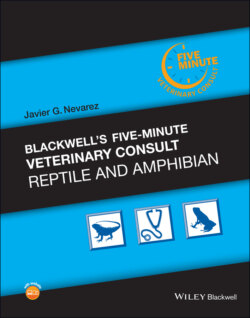Читать книгу Blackwell's Five-Minute Veterinary Consult: Reptile and Amphibian - Javier G. Nevarez - Страница 21
INTEGUMENT
ОглавлениеThe epidermis consists of the stratum corneum with an outer keratin layer, an intermediate lipid‐rich layer and the stratum germinatum with cuboidal cells. Two types of keratin—alpha and beta—are present. Alpha keratin is flexible and is found in hinge regions of the skin, while the more rigid beta keratin provides strength and hardness, as in the shell of chelonians. The wide ventral scales of snakes are called gastropeges. The dermis is composed of connective tissue, blood vessels, lymphatics, and nerves.
Chromatophores are pigment‐containing cells that lie between the epidermis and dermis. They may also occur in the peritoneum. Chromatophores function in camouflage, sexual display, thermoregulation, and behavior. Melanophores are located deep in the sub‐epidermal layer and produce melanins, black, brown, yellow, or gray in color. Carotenoids can be found beneath the epidermis but above melanophores and produce yellow, red, and orange pigments. Iridophores located within the dermis contain guanine (a breakdown product of uric acid), which reflects light in the blue wavelength (Tyndall scattering). The combination of the iridophores’ blue reflection and carotenoid yellow pigmentation create the green coloration common in many reptiles.
Ecdysis is the process by which reptiles shed their skin. Ecdysis is under pituitary and thyroid control. Continuous ecdysis occurs in chelonians and crocodilians while discontinuous ecdysis occurs in snakes, lizards, and tuataras. For simplicity, the ecdysis cycle can be split into a resting phase and a renewal phase, which has up to five stages. During the beginning of the renewal phase, the skin begins to appear duller, as regeneration of cells and enzymatic separation of the skin layers becomes activated. This period lasts approximately 5 ± 2 days. Afterwards, the skin becomes even duller and the spectacles turn opaque in what is commonly described as snakes being in “blue”. This appearance is in large part due to lymphatic fluid accumulation that helps separate the old and new skin layers. This second period lasts 5 ± 2 days, followed by the last stage, during which lymphatic fluid resorption occurs leading to a clearing of the skin and spectacle. At this time, the skin regains some of its sheen and shedding typically occurs 5 ± 2 days after that. Hydration is critical for proper ecdysis and dehydration is a common cause of dysecdysis. The frequency of shedding will vary with environmental temperature, food intake, and growth of the animal.
